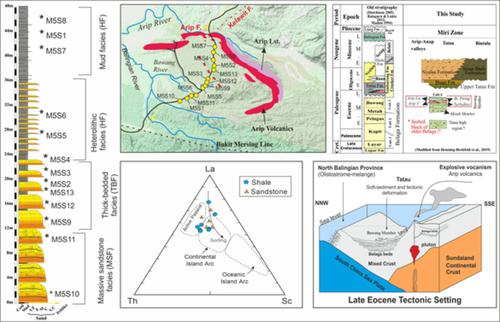当前位置:
X-MOL 学术
›
Geolog. J.
›
论文详情
Our official English website, www.x-mol.net, welcomes your
feedback! (Note: you will need to create a separate account there.)
Geochemistry of Eocene Bawang Member turbidites of the Belaga Formation, Borneo: Implications for provenance, palaeoweathering, and tectonic setting
Geological Journal ( IF 1.4 ) Pub Date : 2020-12-20 , DOI: 10.1002/gj.4062 Nisar Ahmed 1, 2 , Numair A. Siddiqui 1, 3 , Nagarajan Ramasamy 4 , Muthuvairavasamy Ramkumar 5 , Muhammad Jamil 1, 6 , Muhammad Usman 1 , Zulqarnain Sajid 1 , Abdul Hadi Bin Abd Rahman 1
Geological Journal ( IF 1.4 ) Pub Date : 2020-12-20 , DOI: 10.1002/gj.4062 Nisar Ahmed 1, 2 , Numair A. Siddiqui 1, 3 , Nagarajan Ramasamy 4 , Muthuvairavasamy Ramkumar 5 , Muhammad Jamil 1, 6 , Muhammad Usman 1 , Zulqarnain Sajid 1 , Abdul Hadi Bin Abd Rahman 1
Affiliation

|
The Belaga Formation of the Rajang Group or Rajang Fold and Thrust Belt (Late Cretaceous to Late Eocene) is mostly exposed in Sibu Zone along with some exposures in the Miri Zone of Central Sarawak. This entire turbiditic sequence was believed to have been deposited in a deep marine environment in a basin having an overall passive margin setting, that is, the Rajang Sea. However, the Eocene age‐related stratigraphic record of this group (including Bawang Member) is much more complex, due to the complicated geological and tectonic settings which prevailed during their deposition. Here, we present field observations along with the application of various geochemical proxies and their constraints for the understanding of provenance, palaeo‐weathering, and tectonic evolution of the area during the deposition of Bawang turbidites. Based on field observation, it has been found that this member consists of four main lithofacies, including massive sandstone facies (MSF), thick‐bedded facies (TBF), heterolithic facies (HF), and mud facies (MF). Using geochemical data, chemical weathering indices (CIA and CIW) values and A‐CN‐K plot show that the source area for Bawang turbidites has undergone a moderate to an intense degree of chemical weathering and was influenced by the recycling effect. The slight depletion in sandstones and shales for Cr, Ni, and V values is consistent with the felsic dominated source region; however, La/Sc versus Co/Th and La/Th versus Hf plots show a mixed source (felsic and intermediate volcanic source) with some input of recycled sediments from the older sedimentary to metasedimentary rocks. Various geochemical ratios and discriminant diagrams verify that the Schwaner Mountains and its metamorphic group of rocks were the principal provenances for these sediments, along with some input from West Borneo. The results of the geochemical analysis also show that Bawang turbidite sediments were deposited in a basin associated with an initial active continental margin setting and the basin was shifting towards a passive setting (Late Eocene–Oligocene). The volcanic input in Bawang Member during the Late Eocene also suggests the involvement of some subsequent possible arc setting around the “Bawang subbasin”.
中文翻译:

始新世霸王的地球化学婆罗洲Belaga组的混浊浊度:对物源,古风化和构造环境的影响
拉让组或拉让褶皱和逆冲带(晚白垩世至晚始新世)的贝拉加组大部分在诗巫地区暴露,而在砂拉越中部的美里地区也有一些暴露。据信,整个湍流序列都沉积在一个盆地的深海环境中,该盆地具有一个整体的被动边缘环境,即拉让海。然而,由于沉积期间普遍存在复杂的地质和构造环境,该组(包括霸王段)的始新世年龄地层记录要复杂得多。在这里,我们介绍了野外观察以及各种地球化学代理的应用及其对巴旺浊积沉积期间该地区物源,古风化和构造演化的理解的限制。根据现场观察,发现该岩层由四个主要岩相组成,包括块状砂岩相(MSF),厚层相(TBF),异质岩相(HF)和泥浆相(MF)。利用地球化学数据,化学风化指数(CIA和CIW)值以及A‐CN‐K图表明,霸王浊质的来源区经历了中度到强烈的化学风化,并受回收效应的影响。砂岩和页岩中的Cr,Ni和V值略有减少,这与以长英质为主的源区一致。然而,La / Sc与Co / Th以及La / Th与Hf的曲线图显示了混合源(长火山岩和中火山岩源),其中有一些从较旧沉积岩到准沉积岩的再循环沉积物输入。各种地球化学比率和判别图证明,Schwaner山及其变质岩群是这些沉积物的主要来源,同时也有西婆罗洲的一些投入。地球化学分析的结果还表明,霸王浊质沉积物沉积在一个与初始活动大陆边缘环境有关的盆地中,而该盆地正在向被动环境转变(晚始新世-渐新世)。始新世末期霸王河段的火山输入也暗示了随后在“霸王子盆地”周围可能存在的一些弧形环境的参与。地球化学分析的结果还表明,霸王浊质沉积物沉积在一个与初始活动大陆边缘环境有关的盆地中,而该盆地正在向被动环境转变(晚始新世-渐新世)。始新世末期霸王河段的火山输入也暗示了随后在“霸王子盆地”周围可能存在的一些弧形环境的参与。地球化学分析的结果还表明,霸王浊质沉积物沉积在一个与初始活动大陆边缘环境有关的盆地中,而该盆地正在向被动环境转变(晚始新世-渐新世)。始新世末期霸王河段的火山输入也暗示了随后在“霸王子盆地”周围可能存在的一些弧形环境的参与。
更新日期:2020-12-20
中文翻译:

始新世霸王的地球化学婆罗洲Belaga组的混浊浊度:对物源,古风化和构造环境的影响
拉让组或拉让褶皱和逆冲带(晚白垩世至晚始新世)的贝拉加组大部分在诗巫地区暴露,而在砂拉越中部的美里地区也有一些暴露。据信,整个湍流序列都沉积在一个盆地的深海环境中,该盆地具有一个整体的被动边缘环境,即拉让海。然而,由于沉积期间普遍存在复杂的地质和构造环境,该组(包括霸王段)的始新世年龄地层记录要复杂得多。在这里,我们介绍了野外观察以及各种地球化学代理的应用及其对巴旺浊积沉积期间该地区物源,古风化和构造演化的理解的限制。根据现场观察,发现该岩层由四个主要岩相组成,包括块状砂岩相(MSF),厚层相(TBF),异质岩相(HF)和泥浆相(MF)。利用地球化学数据,化学风化指数(CIA和CIW)值以及A‐CN‐K图表明,霸王浊质的来源区经历了中度到强烈的化学风化,并受回收效应的影响。砂岩和页岩中的Cr,Ni和V值略有减少,这与以长英质为主的源区一致。然而,La / Sc与Co / Th以及La / Th与Hf的曲线图显示了混合源(长火山岩和中火山岩源),其中有一些从较旧沉积岩到准沉积岩的再循环沉积物输入。各种地球化学比率和判别图证明,Schwaner山及其变质岩群是这些沉积物的主要来源,同时也有西婆罗洲的一些投入。地球化学分析的结果还表明,霸王浊质沉积物沉积在一个与初始活动大陆边缘环境有关的盆地中,而该盆地正在向被动环境转变(晚始新世-渐新世)。始新世末期霸王河段的火山输入也暗示了随后在“霸王子盆地”周围可能存在的一些弧形环境的参与。地球化学分析的结果还表明,霸王浊质沉积物沉积在一个与初始活动大陆边缘环境有关的盆地中,而该盆地正在向被动环境转变(晚始新世-渐新世)。始新世末期霸王河段的火山输入也暗示了随后在“霸王子盆地”周围可能存在的一些弧形环境的参与。地球化学分析的结果还表明,霸王浊质沉积物沉积在一个与初始活动大陆边缘环境有关的盆地中,而该盆地正在向被动环境转变(晚始新世-渐新世)。始新世末期霸王河段的火山输入也暗示了随后在“霸王子盆地”周围可能存在的一些弧形环境的参与。











































 京公网安备 11010802027423号
京公网安备 11010802027423号